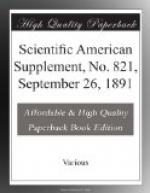Col. A.R. Buffington, commander of the National Armory at Springfield, Mass., has made a steel covered projectile which he prevents from rusting by blackening by a niter process. Several grooves are pressed in the base of the bullet which carry a lubricant, and when the bullet is inserted in the cartridge case the grooves are covered by it. Furthermore, these grooves prevent the lead filling from bursting through the steel casing, leaving the latter in the barrel, as often occurs with the Austrian and French projectiles when using smokeless powder.
A new projectile has lately come out, the invention of Captain Edward Palliser, of the British army. This bullet consists of a jacket made of very soft Swedish wrought iron, coated with zinc and filled with lead, the lead being pressed into this jacket. The bullet is corrugated at its base, after the manner of the one made by Colonel Buffington. This projectile has been experimented with very extensively by the British government, and at the works of the Maxim-Nordenfelt Guns and Ammunition Company, in England. The zinc coating of the bullet is too soft to stick to the barrel of the gun, and also in a measure acts as a lubricant. This projectile has given better results than any other that has been experimented with. The great velocities and the most uniform pressures by the use of smokeless powder have been attained with this Palliser bullet.
NOISELESSNESS.
A great many stories have been told about the noiselessness of smokeless powder. But there is no such thing as a noiseless gunpowder. The report of a gun charged with smokeless powder is very sharp, and is as loud as when black powder is used, yet the volume of sound is much less, so that the report cannot be heard at so great a distance.
The report of a gun using smokeless powder is a sound of much higher pitch than when black powder is used, and consequently cannot be heard at so great a distance as the lower notes given by black powder.
As smokeless powder exerts a much greater pressure than common black powder when burned in a gun, one would naturally think that the recoil of the barrel would be greater, owing to the greater pressure exerted by the smokeless powder on the base of the cartridge case and the breech mechanism. However, such is not the fact; for the barrel actually recoils very much less when smokeless powder is used. This is due to the suddenness with which the pressure is exerted by smokeless powder, it acting more like a very sharp blow on the metal, whereby more of the energy is converted into heat instead of being spent in overcoming the inertia of the barrel to give recoil. Similarly when smokeless powder is fired in a gun, the displacement of the air is so sudden that the sound waves do not possess the same amplitude of recoil or vibration as is given by black powder.
* * * * *




